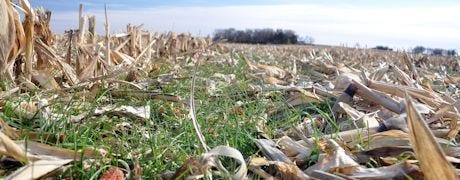
Cover crops are a great way to improve soil health, control soil erosion and reduce nutrient runoff from farm fields. Many Iowa farmers are adding cover crops to their cash crop rotations so the soil stays covered when fields are not growing other crops—such as corn and soybeans. Cover crops also improve soil organic matter and slow water runoff. Cover crops can be aerially seeded into standing corn and soybean crops in late August or early September, prior to harvest. Or cover crops can be seeded on fields—either by drilling or aerially seeding— as soon as possible after the corn or soybeans have been harvested.

COMPARING THE COSTS: A new tool has been created to help farmers calculate and compare the cost of drilling or aerial seeding cover crops. The downloadable Excel file calculates the total cost of establishing a cover crop—including seed, application and chemical termination. You can use the calculator for a single cover crop species or up to six species in a mixture.
Farmers have many questions about including cover crops in the crop rotation. The most often-asked questions include: What kind of cover crop can be planted? Should I seed a single species or a mixture of various kinds of cover crops? There are a number of different species available—ranging from winter rye to turnips to tillage radish. When and how should I seed the cover crop? When and how can I terminate it in the spring, prior to planting corn and soybeans?
With field days and workshops, Iowa Learning Farms strives to help farmers and other interested people, find the answers to these questions and more.
Iowa Learning Farms launches new cover crop calculator tool to help farmers make decisions
To assist farmers in their decision-making, Iowa Learning Farms has launched a new tool to help calculate and compare the costs of using various cover crops including seed, application and chemical termination. Modeled after the popular Ag Decision Maker tools developed by Iowa State University Extension, the cover crop calculator can be used for a single cover crop species or up to six species to a mixture.~~~PAGE_BREAK_HERE~~~
The tool calculates the cost of drilling and aerial application for easy comparison. It is available as an Excel file on the ILF website. To use the calculator, download and open the Excel file (Microsoft Excel software must be installed on your computer). The calculator is available for free and can be downloaded here. Any cell that is shaded in yellow can have a value inserted including the cost of the seed per pound, and the cost of application.
Cover crop acreage is increasing in Iowa and elsewhere in the Midwest, as farmers see short-term and long-term benefits
"Cover crop acres are increasing as more farmers see their short- and long-term benefits," says Mahdi Al-Kaisi, Iowa State University Extension soil management specialist. "In Iowa, winter rye is most commonly planted as a single species and some farmers are using mixes such as rye, oats, tillage radish or turnips. Some cover crops are also being used for grazing livestock or as an extra rotation to produce small grain cover crop seed." To learn more about cover crops visit the ILF website for resources and videos on planting and terminating.
Iowa Learning Farms is building a Culture of Conservation, encouraging adoption of residue management and conservation practices. Farmers, researchers and ILF team members are working together to identify and implement the best in-field management practices that increase water and soil quality while remaining profitable. Iowa Learning Farms is a partnership between Iowa Department of Agriculture & Land Stewardship, Iowa State University Extension, Leopold Center for Sustainable Agriculture, USDA's Natural Resources Conservation Service in Iowa and the Iowa Department of Natural Resources; in cooperation with Conservation Districts of Iowa, Iowa Farm Bureau and the Iowa Water Center.
About the Author(s)
You May Also Like




